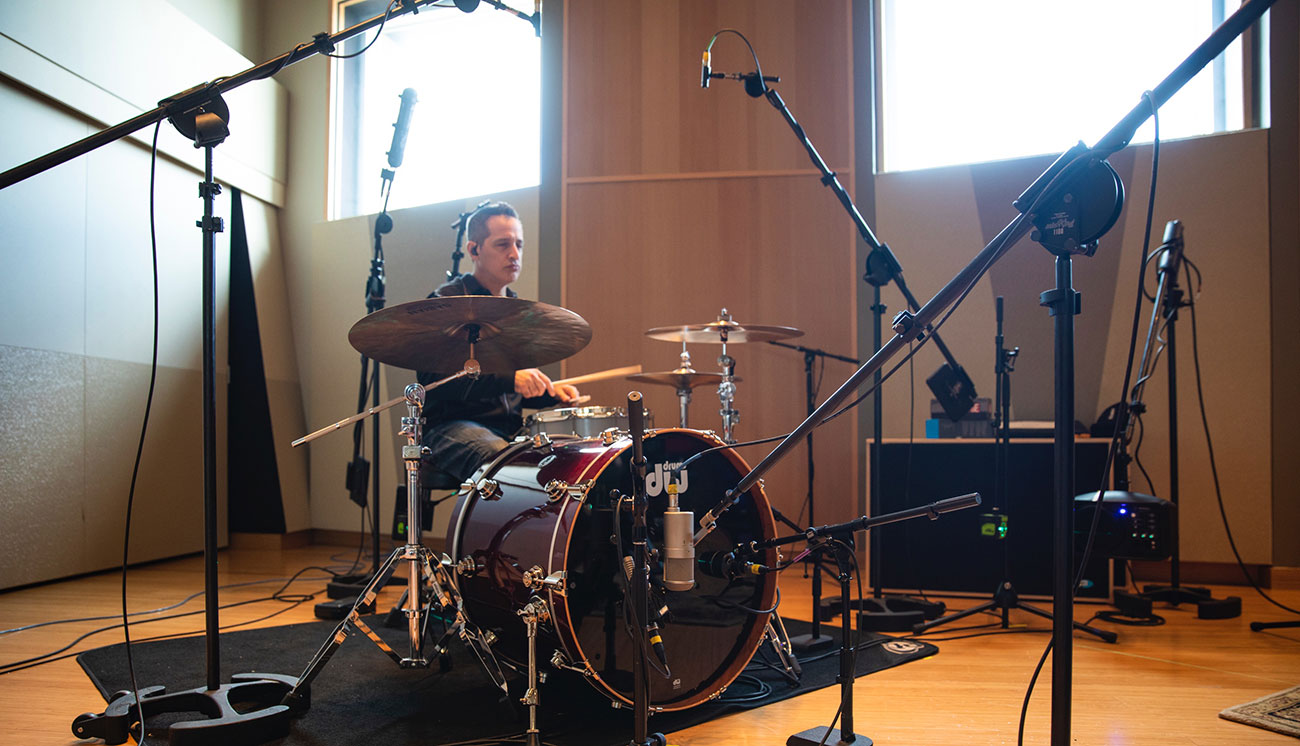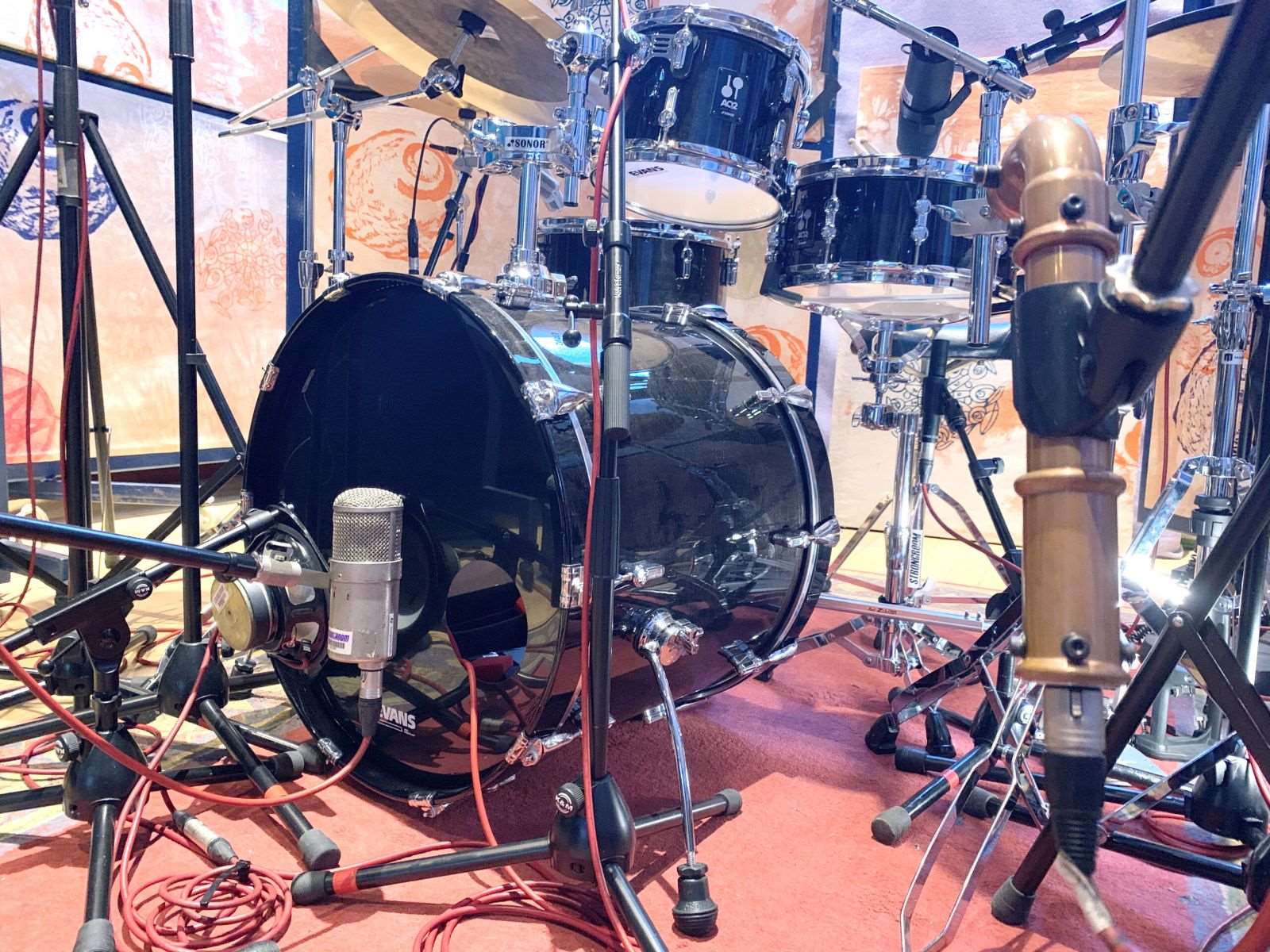Home>Instruments>Bass>How Much Does A Marching Bass Drum Weigh


Bass
How Much Does A Marching Bass Drum Weigh
Published: November 29, 2023
Learn the weight of a marching bass drum and find out how it impacts your performance. Discover tips to choose the perfect bass drum weight.
(Many of the links in this article redirect to a specific reviewed product. Your purchase of these products through affiliate links helps to generate commission for AudioLover.com, at no extra cost. Learn more)
Table of Contents
- Introduction
- The Importance of Weight in Marching Bass Drums
- Factors Affecting the Weight of Marching Bass Drums
- Different Weight Ranges for Marching Bass Drums
- Common Materials Used in Manufacturing Marching Bass Drums
- Techniques to Reduce the Weight of a Marching Bass Drum
- Impact of Weight on Performance and Mobility
- Conclusion
Introduction
The marching bass drum is one of the most powerful and essential instruments in a marching band. Its deep, resonant sound adds a strong foundation to the overall musical ensemble. However, when it comes to marching with this imposing instrument, weight becomes a crucial factor. The weight of a marching bass drum not only affects the mobility and comfort of the player but also influences the sound projection and overall performance quality.
In this article, we will delve into the world of marching bass drums and explore the significance of weight in this instrument. We will discuss the factors that affect the weight of marching bass drums, the different weight ranges available, and the common materials used in their construction. Additionally, we will look at techniques to reduce the weight of a marching bass drum without compromising its sound quality or durability. Lastly, we will examine the impact of weight on the performance and mobility of marching bass drummers.
Whether you are a marching band enthusiast or a budding percussionist, understanding the importance of weight in marching bass drums will give you valuable insights into choosing the right instrument and improving your overall marching band experience. So, let’s dive into the world of marching bass drums and uncover the secrets behind their weight!
The Importance of Weight in Marching Bass Drums
The weight of a marching bass drum plays a crucial role in the overall performance and mobility of the drummer. It not only affects their ability to maneuver and play the instrument comfortably but also impacts the sound projection and quality of the drum itself.
When it comes to marching band performances, mobility is of utmost importance. Drummers need to be able to move swiftly and smoothly while playing intricate patterns and keeping in sync with the rest of the band. A heavy bass drum can hinder this mobility, making it difficult for the drummer to keep up with the marching formations and execute precise movements.
Moreover, playing a heavy bass drum for an extended period can cause fatigue and discomfort for the drummer. This can negatively impact their playing technique and overall performance. A lighter drum allows the drummer to maintain a more relaxed and natural playing posture, reducing the risk of strain or injury.
Another significant aspect affected by the weight of a marching bass drum is the sound projection. The weight of the drum contributes to the overall resonance and depth of the sound produced. A heavier drum tends to produce a fuller and more booming sound, which may be ideal for certain musical styles or venues. On the other hand, a lighter drum may have a brighter and crisper sound, which could be preferable in a different musical context.
Furthermore, the weight of the drum can influence the drumhead tension and the overall balance of the instrument. Drummers often adjust the tension of the drumheads to achieve the desired sound and feel. A lighter drum allows for easier adjustments and fine-tuning of the drumhead tension, enabling the drummer to optimize the sound output.
Overall, the weight of a marching bass drum is a critical factor that affects both the drummer’s performance capabilities and the sound characteristics of the instrument. Striking the right balance between weight and functionality is essential to ensure a comfortable and enjoyable playing experience while delivering a powerful and resonant sound.
Factors Affecting the Weight of Marching Bass Drums
Several factors come into play when determining the weight of a marching bass drum. These factors can vary depending on the manufacturer, the desired sound characteristics, and the specific requirements of the marching band. Let’s explore some of the key factors affecting the weight of marching bass drums:
- Drum Size: The size of the marching bass drum greatly influences its weight. Larger drums typically weigh more due to the increased surface area and the need for additional structural support to maintain stability and durability.
- Shell Material: The type of material used for the drum shell has a significant impact on its weight. Common materials include wood, fiberglass, and aluminum. Wood shells are typically heavier but offer warm and rich tones, while fiberglass and aluminum shells are lighter but may have a brighter sound.
- Hardware Components: The hardware components of a marching bass drum, such as lugs, hoops, tension rods, and mounting systems, can significantly contribute to its overall weight. Manufacturers often use lightweight materials and design structures to minimize weight while maintaining strength and functionality.
- Number of Ply: The number of plies in a drum shell affects its weight. A higher ply count generally results in a heavier drum but provides added durability and potential for deeper sound projection.
- Finishes and Accessories: Finishes and additional accessories such as wraps, graphics, or customizations can also impact the weight of a marching bass drum. These additions may add some extra weight but can enhance the visual appeal of the instrument.
It is important to note that there is a delicate balance between weight, sound quality, and durability. While lighter drums may offer improved mobility and comfort, they may sacrifice some of the low-end resonance and projection. Conversely, heavier drums may provide a fuller sound but could be more challenging to maneuver.
Manufacturers constantly strive to find the optimal balance between these factors, taking into consideration the preferences of drummers and the specific requirements of marching bands. By carefully considering these factors, drummers can select a marching bass drum that best suits their playing style, sound preferences, and physical capabilities.
Different Weight Ranges for Marching Bass Drums
Marching bass drums come in various weight ranges, each offering distinct characteristics and benefits. The weight of a drum is typically measured in pounds (lbs) or kilograms (kg). Let’s explore the different weight ranges commonly found in marching bass drums:
- Lightweight: Lightweight marching bass drums typically range from 15-20 pounds (6.8-9.1 kg). These drums are designed with a focus on mobility and ease of movement. They provide excellent comfort for the drummer, allowing for precise maneuvers and quick transitions. Lightweight drums are popular in marching bands that prioritize dynamic movement and intricate choreography.
- Medium Weight: Medium-weight marching bass drums typically weigh between 20-25 pounds (9.1-11.3 kg). These drums strike a balance between mobility and sound projection. They offer a good compromise for drummers who need a responsive instrument with decent volume and resonance without sacrificing too much in terms of weight. Medium-weight drums are commonly used in a variety of marching band settings.
- Heavyweight: Heavyweight marching bass drums weigh around 25 pounds (11.3 kg) or more. These drums prioritize sound projection and deep resonant tones. They are often preferred in outdoor marching events, where it is crucial to cut through the ambient noise and provide a commanding presence. While heavyweight drums may be more challenging to maneuver, they offer a powerful and robust sound that can make a significant impact on the overall band performance.
It is important to choose a marching bass drum weight range that aligns with your personal preferences, physical capabilities, and performance requirements. Consider your playing style, the musical genre you specialize in, and the specific demands of your marching band. Experimenting with different weight ranges and seeking expert advice can help you find the ideal balance between comfort, mobility, and sound quality.
Keep in mind that individual drummers may have unique preferences when it comes to weight, and what works well for one person may not work for another. Therefore, it’s essential to try out different drums within your desired weight range and make an informed decision based on your personal experience and requirements.
Common Materials Used in Manufacturing Marching Bass Drums
The choice of materials in the construction of a marching bass drum greatly influences its weight, sound characteristics, and durability. Manufacturers utilize a variety of materials to achieve the desired balance between these factors. Let’s explore some of the common materials used in the manufacturing of marching bass drums:
- Wood: Wood is a traditional and popular choice for marching bass drum shells. Common types of wood used include maple, birch, and mahogany. Wood shells offer warm and rich tones with excellent depth and resonance. However, wood shells are generally heavier compared to other materials, which can impact the overall weight of the drum.
- Fiberglass: Fiberglass shells are lightweight and provide bright and focused tones. They offer excellent projection and are highly durable, making them suitable for outdoor performances. Fiberglass shells are less influenced by changes in temperature and humidity, making them more stable than wood shells. However, they may not provide the same warmth and depth as wood shells.
- Aluminum: Aluminum shells are known for their lightweight and bright sound characteristics. They offer excellent projection and a snappy attack. Aluminum shells are highly durable and resistant to temperature and humidity changes, making them ideal for various performance environments. However, they may lack the warmth and sustain found in wood shells.
- Hybrid: Some manufacturers use a combination of materials in the construction of marching bass drum shells to leverage the advantages of different materials. For example, a hybrid shell may consist of an outer fiberglass layer for durability and projection, along with an inner wood layer for warmth and resonance. This amalgamation of materials provides a unique blend of sound characteristics.
In addition to the shell material, other components such as hoops, lugs, tension rods, and mounting systems are typically made from lightweight metals or alloys to minimize weight while maintaining strength and functionality. These components are carefully designed to ensure proper drumhead tension and overall performance.
Ultimately, the choice of materials in a marching bass drum depends on the desired sound characteristics, portability, and durability. It’s essential to consider your playing style, musical preferences, and the specific needs of your marching band when selecting a drum with the right combination of materials.
Consulting with experienced percussionists and trying out different drums made from various materials can help you find the marching bass drum that best suits your playing style and delivers the desired sound for your performances.
Techniques to Reduce the Weight of a Marching Bass Drum
Reducing the weight of a marching bass drum can greatly enhance the mobility and comfort of the drummer without compromising the instrument’s sound quality or durability. Here are some techniques and strategies commonly employed to achieve a lighter marching bass drum:
- Shell Construction: Choosing a drum with a lightweight shell material, such as fiberglass or hybrid constructions, can significantly reduce the overall weight of the bass drum while maintaining optimal sound projection and resonance.
- Hardware Selection: Opting for lightweight hardware components, including lugs, tension rods, and mounting systems, can help reduce the weight without compromising the structural integrity and functionality of the drum.
- Drumhead Selection: Selecting lighter drumheads can contribute to weight reduction. There are various drumhead options available that are specifically designed to be lightweight while still providing the desired sound and durability.
- Using Carbon Fiber Reinforcement: Introducing carbon fiber reinforcement in key areas of the drum, such as the hoops or shell, can provide added strength and stability while reducing overall weight. Carbon fiber is known for its lightweight and robust characteristics.
- Simplified Design: Streamlining the design of the bass drum by minimizing unnecessary embellishments, excessive hardware, or additional accessories can help reduce weight. Keeping the design simple and functional can contribute to a lighter drum.
- Proper Drumhead Tension: Maintaining proper drumhead tension is crucial for optimal sound quality and playability. Over-tensioning the drumheads can not only affect the sound but also add unnecessary weight. Regularly tuning and adjusting the drumheads to the appropriate tension will ensure a balanced sound while keeping the drum lightweight.
- Regular Maintenance: Taking proper care of the marching bass drum, including cleaning, protecting it from extreme temperatures, and storing it correctly, can help prolong its lifespan and prevent any unnecessary weight gain due to damage or wear and tear.
It is important to note that while reducing the weight of a marching bass drum is beneficial, it should not be done at the expense of compromising sound quality or structural integrity. Striking the right balance between weight reduction and maintaining optimal performance is key.
By implementing these techniques and considering lightweight alternatives in the manufacturing and maintenance of the bass drum, drummers can enjoy improved mobility, reduced fatigue, and enhanced performance while marching.
Impact of Weight on Performance and Mobility
The weight of a marching bass drum has a significant impact on the performance and mobility of the drummer. Here are some key aspects affected by the weight of the instrument:
1. Mobility: A heavy bass drum can hinder the mobility of the drummer, making it difficult to move quickly and smoothly while executing marching band formations or complex choreography. Drummers need to be able to navigate the field or parade route with ease and precision. A lighter bass drum allows for greater mobility, making it easier to transition between movements and maintain proper footwork.
2. Comfort: Drumming for extended periods with a heavy bass drum can lead to discomfort and fatigue. As the weight bears down on the drummer’s body, it can strain their muscles and potentially affect their playing technique. A lighter bass drum offers improved comfort, allowing drummers to maintain a more relaxed and natural playing posture. This can enhance endurance and prevent the onset of fatigue, leading to a more consistent and enjoyable performance.
3. Technique: The weight of the bass drum also influences the drummer’s technique. With a lighter instrument, drummers can have more control and precision in their movements, enabling them to play intricate patterns accurately. On the other hand, a heavy drum can make it challenging to execute complex drumming techniques and intricate rhythms. Lighter drums allow for faster stick control and improved agility, facilitating the drummer’s ability to deliver dynamic and expressive performances.
4. Sound Projection: The weight of the drum can affect its sound projection and overall volume. A heavier bass drum tends to produce a fuller and more resonant sound, which can be advantageous in certain musical contexts or outdoor performances where sound projection is crucial. Conversely, a lighter drum may have a brighter and more focused sound. It’s important for drummers to consider the specific sound characteristics they desire and choose a bass drum weight that aligns with their musical goals and performance requirements.
5. Endurance: Drumming with a heavy bass drum requires greater physical exertion and can lead to faster fatigue. This can impact the drummer’s endurance and consistency throughout a performance. A lighter bass drum reduces the strain on the drummer’s body, allowing them to maintain a steady and powerful playing style for longer periods. Improved endurance translates to more energized and impactful performances.
When choosing a marching bass drum, it’s important to find the right balance between weight and functionality. Consider your personal physique, playing style, and the demands of your marching band. Each drummer may have different preferences when it comes to weight, so it’s important to experiment and find the weight range that best suits your individual needs and enhances your overall performance and mobility.
Conclusion
The weight of a marching bass drum is a crucial factor that impacts the performance, mobility, and overall experience of the drummer. Understanding the importance of weight in marching bass drums allows drummers to make informed decisions when selecting their instruments and enhances their ability to deliver outstanding performances.
Factors such as drum size, shell material, hardware components, and finishes all contribute to the weight of a marching bass drum. By carefully considering these factors, drummers can find the optimal balance between weight and functionality that aligns with their playing style, sound preferences, and physical capabilities.
Techniques such as selecting lightweight materials, using carbon fiber reinforcement, and proper drumhead tension can help reduce the weight of a marching bass drum without compromising its sound quality or durability. These techniques enhance the mobility, comfort, and endurance of the drummer, resulting in improved performances.
It’s important to remember that personal preferences and specific performance requirements may vary. Therefore, it’s crucial for drummers to experiment with different weight ranges and seek expert advice when choosing a marching bass drum.
By finding the right balance between weight, sound quality, and mobility, drummers can fully leverage the power of the marching bass drum to enhance their marching band experience and captivate audiences with their rhythm and musicality.
So, whether you’re a seasoned percussionist or a beginner, take the time to explore the world of marching bass drums and discover the perfect instrument that will elevate your performance to new heights.











